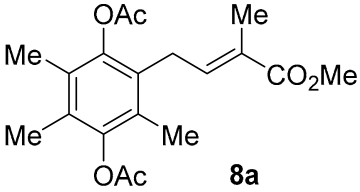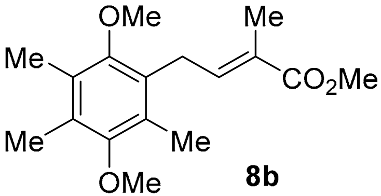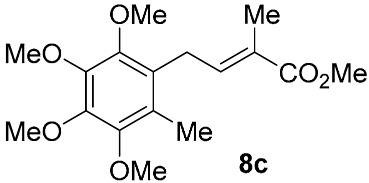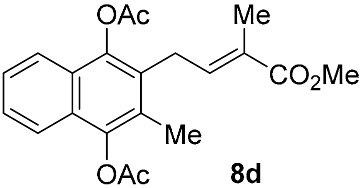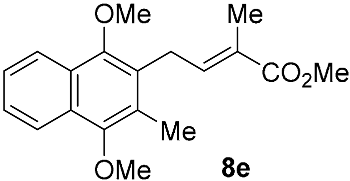Abstract
An alternative catalytic strategy for the preparation of benzylmethacrylate esters, key intermediates in the synthesis of coenzyme Q10 and derivatives, was reported. This strategy avoided undesirable stoichiometric reduction/oxidation processes by utilizing the catalytic formation of allylarenes and then cross-metathesis to selectively form E-benzylmethacrylate esters with good yields (58–64%) and complete E-selectivity. The ester intermediates were reduced to common key benzylallylic alcohols (90–92% yield), which were subsequently used in the formal syntheses of coenzyme Q10 and one derivative.
1. Introduction
Coenzyme Q10 (1), an isoprenylated quinone, is a critical electron-transfer compound found in all respiring eukaryotic cells [1,2,3]. The demand for commercial coenzyme Q10 calls for efficient artificial syntheses of this compound [4,5,6,7,8,9,10,11]. The frame of coenzyme Q10 can be viewed as a combination of terpenyl and aromatic fragments. Therefore, the simplest terpenyl moiety from solanesol, found in tobacco leaves, and the common aromatic moiety benzylallyl alcohol (2c) were utilized to build up coenzyme Q10 molecule [11]. In particular, previous studies [11] have utilized a Friedel–Craft allylation of a quinol derivative with 2-methylbut-3-en-2-ol followed by a series of oxidation/reduction reactions to achieve the desired target (2c). Alcohol (2c) was then used in transformations with the solanesyl bromide obtained from the bromination of solanesol to achieve coenzyme Q10 (Scheme 1). This strategy served as the framework for the synthesis of coenzyme Q10 based on the terpenyl chain from solanesol.
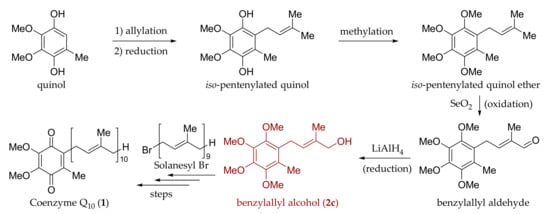
Scheme 1.
A previous stoichiometric approach to coenzyme Q10 through benzylallyl alcohol (2c).
However, the preparation of the iso-pentenylated quinol in the reported work unexpectedly required an additional reduction step. Re-examining the transformation, we found that quinone, the oxidized form of the desired iso-pentenylated quinol, was in fact the major product in an inseparable mixture of the two compounds. Indeed, upon exposure to air, all the amount of expected quinol was oxidized to its corresponding quinone after 45 min. A similar unexpected oxidation was also observed by the Hecht group [12]. This result led to an undesirable stoichiometric reduction step being added to the synthesis. The iso-pentenylated quinol was stoichiometrically oxidized by SeO2 to aldehyde, not alcohol, and therefore required an extra reduction step to obtain the benzylallyl alcohol (2c). The whole procedure to prepare the aromatic moiety was, therefore, accompanied by unenviable stoichiometric oxidation/reduction reactions. With the advantages of known catalytic processes, we anticipated that suitable catalytic transformations such as Claisen rearrangement, Stille coupling, and cross-metathesis could offer additional strategies and allow for catalytic access of coenzyme Q10 and derivatives.
Design Plan
We hypothesized that extra reduction/oxidation steps for preparing benzylallyl alcohol (2c) quinol were required because the previous research used readily oxidizable quinol, and unfunctionalized iso-pentenyl group. We envisioned that allyarene (7) (Scheme 2) could be prepared from commercially available aryl bromides (3) by Stille coupling. This allylarene could then undergo a cross-metathesis reaction with the methyl methacrylate to offer the desired E-cross-metathesis products [13,14,15,16], which could be further reduced to the key synthetic intermediate benzyl alcohols (2). This catalytic strategy would allow for alternative access to common key intermediates in the syntheses of coenzyme Q10 and derivatives.

Scheme 2.
Our catalytic approach to benzylallyl alcohols (2).
2. Results and Discussion
To examine the proposed idea, five allylated arenes (7a–e) were prepared. These allylarenes were synthesized either from commercially available aryl bromide 3 (path A) [17,18,19] or monoacetylquinol 4 (path B) [20,21,22,23,24]. (Scheme 3) The Stille coupling of corresponding (MeO)2 aryl bromides with allyltributylstannane directly afforded allylarenes 7b–c and 7e with high yields (75%–78%). Diacetate allylarenes 7a and 7d were prepared from corresponding quinol derivatives (4). First, quinols 4(a and d) were allylated to provide allyl ethers 5a (84%), and 5b (82%), which then participated in the Claisen rearrangement to furnish allylated quinols 6a (78%) and 6d (55%). Allylated quinols 6a and 6d were then acetylated with Ac2O to afford 7a (59% overall yield) and 7d (41% overall yield).
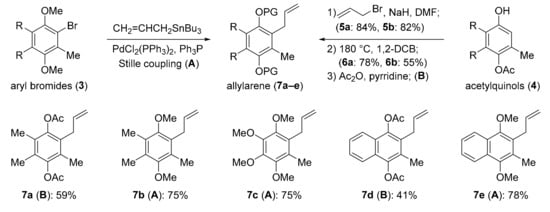
Scheme 3.
Preparation of allylarenes.
Next, the cross-metathesis of allylated arenes with methyl methacrylate was studied. The results are shown in Table 1. Initially, the cross-metathesis reaction of 7a was carried out in neat methyl methacrylate (Table 1, Entry 1). However, only a trace amount of the desired product was obtained. The reaction was then conducted in dichloromethane with a ratio of one equivalent of allylarene 7a and five equivalents of methyl methacrylate. In this case, we mostly obtained the homo-coupling of allyarene (Table 1, Entry 2). Increasing the amount of methyl methacrylate to 20 equivalents, we were able to isolate desired the product 8a with 56% yield and exclusive E-configuration based on NOESY NMR spectroscopy analysis. This result was consistent with the previous studies [13,14,15,16]. The reaction condition was also applied to allylarenes 7b–e. All cross-metathesis reactions generated desired E isomers with moderate to good yields (8b–e, 58–65% yields) providing the key intermediates for the syntheses of coenzyme Q10 and derivatives (8a–e).

Table 1.
Cross-metathesis products.
We then reduced esters 8b,c,e by LiAlH4 to corresponding alcohols 2b,c,e with very good yields (90%–92% yield) (Scheme 4). These alcohols could be used in well-established synthetic paths to furnish coenzyme Q10 [25] (from 2c) and its derivatives.

Scheme 4.
Reduction of allylesters.
Synthesis of a Coenzyme Q10’s Derivative
Following a similar procedure for the formal synthesis of coenzyme Q10 [25], we obtained derivative 12 from the corresponding key alcohol (2b) (Scheme 5). First, the alcohol (2b) was converted into allyl bromide (9) (crude yield: 90%). The bromide (9, without purifying) was then treated with PhSO2Na to obtain the phenylsulfinate (10: 62%). The sulfinate (10) was then subjected to an allylation event with solanesyl bromide in the presence of tBuOK to form 11 with a moderate yield (58%). Finally, the de-sulfination of 11 afforded the coenzyme Q10′s derivativate (12: 43%)
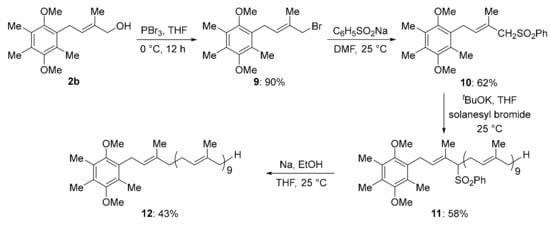
Scheme 5.
Synthesis of coenzyme Q10 derivative (12).
3. Materials and Methods
3.1. General Information
Commercial reagents were purified prior to use following the guidelines of Perrin and Armarego [26]. All solvents were redistilled before using. Reactions under N2 atmosphere were performed with a Schlenk apparatus or simple dry-box (Laboratory build, Hanoi, Vietnam). Organic solutions were concentrated under reduced pressure on a Büchi rotary evaporator using an ice-water bath for volatile compounds. Chromatographic purification of products was accomplished by flash chromatography on silica gel according to the method of Still [27]. Thin-layer chromatography (TLC) was performed on Merk silica gel plates. Visualization of the developed chromatogram was performed by fluorescence quenching, p–anisaldehyde, ceric ammonium molybdate, or potassium permanganate stains. 1H and 13C NMR spectra were recorded on a Bruker Advance–III 500 (500 and 125 MHz) instrument (Bruker Corp., Billerica, MA, USA) in the Faculty of Chemistry, VNU University of Science, Vietnam National University, Hanoi, Vietnam, and were internally referenced to residual protic solvent signals (note: CDCl3 referenced at d 7.27 and 77.0 ppm respectively). 13C NMR spectra were recorded in J-MOD (J-modulated spin-echo) mode, which were the combination of 13C and DEPT without losing quaternary 13C signals. Data for 1H NMR are reported as follows: chemical shift (δ ppm), multiplicity (s = singlet, d = doublet, t = triplet, q = quartet, h = heptet, m = multiplet, b = broad), integration, coupling constant (Hz), and assignment. Data for 13C NMR are reported in terms of chemical shift and multiplicity; no special nomenclature has been used for equivalent carbons. The IR spectrum (Supplementary Materials) of alcohol 4 was recorded on the Shimadzu FTIR Affinity-1S (Shimadzu Corp., Kyoto, Japan) in the Department of Inorganic Chemistry, Faculty of Chemistry, VNU University of Science, Vietnam National University and has been reported in terms of frequency of absorption. High-resolution mass spectra were obtained via ESI method on Agilent 6530 Accurate-Mass Q-TOP LC/MS (Agilent Technonogy Inc., Santa Clara, CA, USA) in the Institute of Marine Biochemistry, Vietnam Academy of Science and Technology Hanoi, Vietnam.
3.2. General Procedure for Allylation Reaction
NaH (0.78 g, 32.5 mmol) was slowly added to the solution of phenol (16 mmol) in DMF (60 mL) at 0 °C under an N2 atmosphere. The reaction mixture was stirred vigorously for 30 min to evaporate the gas in solution. After that, allyl bromide (2.18 mL, 25.2 mmol) was slowly added to the reaction flask and refluxed at 40 °C for 12 h. The mixture was poured into ice-water and extracted with ethyl acetate. The organic layer was washed with brine, dried over Na2SO4, and evaporated under vacuum. The residue was purified via flash column chromatography with silica gel as the stationary phase (0%–2% ethyl acetate/n-hexane) to yield the titular allyl aryl ether.
4-(Allyloxy)-2,3,6-trimethylphenyl acetate (5a): clear oil, 84% yield. IR (film) 2976, 2918, 2864, 1759, 1744, 1599, 1584, 1404, 1357, 1211, 1161, 1111, 1084, 937, 895, 839, 768, 745 cm–1; 1H NMR (500 MHz, CDCl3) δ 6.58 (s, 1H), 6.14–6.02 (m, 1H), 5.44 (dq, J = 17.3, 1.7 Hz,1H), 5.28 (dq, J = 10.5, 1.5 Hz, 1H), 4.50 (dt, J = 5.0, 1.6 Hz, 2H), 2.34 (s, 3H), 2.18 (s, 3H), 2.13 (s, 3H), 2.07 (s, 3H); 13C NMR (125 MHz, CDCl3) δ 169.5, 154.2, 141.8, 133.8, 129.8, 127.1, 124.3, 116.9, 111.6, 69.4, 20.6, 16.7, 13.1, 12.1; HRMS (ESI) exact mass calculated for [M + H]+ (C14H19O3) requires m/z 235.1334, found m/z 235.1329.
4-(allyloxy)-2-methylnaphthalen-1-yl acetate (5d): clear oil, 82% yield. IR (film) 3073, 2918, 2862, 1759, 1744, 1632, 1599, 1506, 1462, 1404, 1356, 1269, 1202, 1159, 1111, 1084, 937, 895, 839, 768, 745 cm–1; 1H NMR (500 MHz, CDCl3) δ 8.26 (d, J 8.3 Hz, 1H), 7.67 (d, J = 8.4 Hz, 1H), 7.52–7.48 (m, 1H), 7.45–7.42 (m, 1H), 6.65 (s, 1H), 6.20–6.14 (m, 1H), 5.53 (dd, J = 17.3, 1.5 Hz, 1H), 5.34 (dd, J = 6.8, 1 Hz, 1H), 4.70 (d, J 5.1 Hz, 2H), 2.46 (s, 3H), 2.30 (s, 3H); 13C NMR (125 MHz, CDCl3) δ 169.6, 152.3, 137.8, 133.2, 127.9, 127.2, 126.3, 124.9, 122.6, 120.6, 117.6, 107.7, 69.3, 20.7, 16.9; HRMS (ESI) exact mass calculated for [M + H]+ (C16H17O3) requires m/z 257.1178, found m/z 257.1172.
3.3. General Procedure for Claisen Rearrangement
A solution of allyl aryl ether (11 mmol) in 1,2-dichlorobenzene (50 mL) was stirred for 24 h at 180 °C under an N2 atmosphere. The mixture was purified by column chromatography with silica gel as the stationary phase (0%–5% ethyl acetate/n-hexane) to yield the titular allylphenol.
3-allyl-4-hydroxy-2,5,6-trimethylphenyl acetate (6a): yellow solid, 78% yield, mp = 119–120 °C. IR 3485, 2924, 1728, 1639, 1574, 1458, 1365, 1300, 1225, 1192, 1070, 993, 905 cm–1; 1H NMR (500 MHz, CDCl3) δ 6.01–5.88 (m, 1H), 5.11–5.02 (m, 2H), 4.79 (s, 1H), 3.41 (dt, J = 10.0, 3 Hz, 2H), 2.34, (d, J = 0.5 Hz, 2H), 2.15 (s, 5H), 2.05 (s, 6H); 13C NMR (125 MHz, CDCl3) δ 169.8, 150.1, 141.8, 135.5, 127.6, 126.4, 121.7, 121.4, 116.1, 31.5, 20.7, 13.3, 12.8, 12.3; HRMS (ESI) exact mass calculated for [M + H]+ (C14H19O3) requires m/z 235.1334, found m/z 235.1329.
3-allyl-4-hydroxy-2-methylnaphthalen-1-yl acetate (6d): light yellow crystal, 55% yield, mp = 117–118 °C. IR 3485, 3441, 3063, 2976, 2924, 1726, 1634, 1595, 1574, 1454, 1389, 1364, 1290, 1233, 1080, 1047, 1015, 982, 914, 768, 737 cm–1; 1H NMR (500 MHz, CDCl3) δ 8.11 (d, J = 7.5 Hz, 1H), 7.66 (d, J = 7.6 Hz, 1H), 7.49–7.43 (m, 2H), 6.07–6.00 (m, 1H), 5.36 (s, 1H), 5.17 (dq, J = 10.1, 1.6 Hz, 1H), 5.11 (dq, J = 18.9, 1.7 Hz, 1H), 3.59 (dt, J = 5.6, 1.7 Hz, 2H), 2.47 (s, 3H), 2.25 (s, 3H); 13C NMR (125 MHz, CDCl3) δ 169.7, 147.7, 138.4, 135.0, 126.7, 126.5, 126.5, 125.3, 124.0, 121.7, 120.8, 118.2, 116.7, 31.4, 20.8, 13.5; HRMS (ESI) exact mass calculated for [M + H]+ (C16H17O3) requires m/z 257.1178, found m/z 257.1172.
3.4. General Procedure for Acetylation
Acetic anhydride (1 mL, 10 mmol) was added to the mixture of allylphenol (5 mmol) and pyridine (10 mL) at 0 °C under an N2 atmosphere. After that, 4-dimethyl pyridine (0.15 g, 1 mmol) was added as catalyst. The reaction mixture was stirred for 1 h at room temperature. After completion, the mixture was poured into water and extracted with ethyl acetate. The organic layer was washed with water, saturate aqueous CuSO4 and brine, dried over Na2SO4, and evaporated under vacuum. The residue was purified by column chromatography with silica gel as the stationary phase (0%–5% ethyl acetate/n-hexane) to yield the titular allyl ester.
2-allyl-3,5,6-trimethyl-1,4-phenylene diacetate (7a): light yellow crystal, 90% yield, mp = 108–109 °C. IR 3458, 3074, 2976, 2927, 1728, 1639, 1573, 1460, 1366, 1225, 1192, 1070, 993, 905, 860, 827, 706, 683 cm–1; 1H NMR (500 MHz, CDCl3) δ 5.81–5.76 (m, 1H), 5.00 (dq, J = 10.1, 1.6, 1H), 4.94 (dd, J = 17.1, 1H), 3.27 (bd, J = 39.5 Hz, 2H), 2.34 (s, 3H), 2.31 (s, 3H), 2.06 (b, 6H, 2CH3), 2.04 (s, 3H); 13C NMR (125 MHz, CDCl3) δ 169.1 (b, 2 × C=O), 145.8, 145.6, 134.9, 128.4, 127.9, 127.7, 127.6, 127.4, 115.7, 31.8 (b, 2CH3CO), 20.5, 13.3, 12.7; HRMS (ESI) exact mass calculated for [M + Na]+ (C16H20NaO4) requires m/z 299.1259, found m/z 299.1257.
Our above NMR data for prepared compound (7a) were comparable with the NMR data of 2-allyl-1,4-diacetoxy-3,5,6-trimethylbenzen in Reference [28]: 1H NMR (90 MHz, CDCl3) δ 5.7–5.9 (m, 1H), 5.0 (d, J = 11, 1 H), 4.94 (d, J = 18, 1H), 3.28 (br s, 2H), 2.32 and 2.34 (s, 6H), 2,04 and 2,06 (s, 9H); 13C NMR δ 168.90, 168.70, 145.97, 145.72, 134.97, 128.47, 127.92, 127.53, 127.36, 115.4, 31.78, 20.42, 20.29, 13.07, 12.47.
2-allyl-3-methylnaphthalene-1,4-diyl diacetate (7d): brown solid, 90% yield, mp = 107–108 °C. IR 3069, 2982, 2928, 2870, 1753, 1639, 1599, 1427, 1354, 1198, 1169, 1092, 1049, 1011, 895, 773, 742 cm–1; 1H NMR (500 MHz, CDCl3) δ 7.72–7.71 (m, 1H), 7.67–7.65 (m, 1H), 7.48–7.46 (m, 2H), 5.91–5.86 (m, 1H), 5.06 (dq, J = 10.2, 1.6, 1H), 4.99 (dq, J = 17.1, 1.7, 1H), 3.48 (b, 2H), 2.49 (s, 3H), 2.47 (s, 3H), 2.27 (s, 3H); 13C NMR (125 MHz, CDCl3) δ 169.6 (2 × C=O) 142.9, 142.8, 134.7, 128.4, 127.1, 126.7, 126.6, 126.5, 126.3, 121.6, 121.4, 116.3, 32.1, 20.9, 20.8, 13.2. HRMS (ESI) exact mass calculated for [M + H]+ (C18H19O4) requires m/z 299.1283, found m/z 299.1282.
3.5. General Procedure for Stille Coupling
Bromoaryl (1.0 mmol), (PPh3)2PdCl2 (0.025 mmol) allylSnBu3 (1.1 mmol), and PPh3 (0.1 mmol) were dissolved in DMF (10 mL), and then the mixture was heated at 110 °C for 4 h under an N2 atmosphere. The reaction mixture was diluted with H2O, extracted five times with Et2O, and the combined extracts were dried over Na2SO4 and evaporated under vacuum. The residue was purified by column chromatography with silica gel as the stationary phase (10%–20% ethyl acetate/n-hexane) to yield the titular allylated arene.
1-allyl-2,5-dimethoxy-3,4,6-trimethylbenzene (7b): clear oil, 75% yield. IR (film) 2994, 2936, 2845, 1638, 1558, 1454, 1383, 1223, 1084, 1038, 1002, 937, 837, 758 cm–1; 1H NMR (500 MHz, CDCl3) δ 5.97–5.92 (m, 1H), 5.00 (dq, J = 10.0, 1.9 Hz, 1H), 4.90 (dq, J = 17.5, 2.0 Hz, 1H), 3.66 (s, 3H), 3.64 (s, 3H), 3.43 (dt, J = 4.0 Hz, 1.7 Hz, 2H), 2.19 (s, 9H); 13C NMR (125 MHz, CDCl3) δ 153.2, 153.0, 136.9, 129.3, 128.9, 128.2, 128.1, 114.9, 61.2, 60.3, 31.4, 12.9, 12.8, 12.0; HRMS (ESI) exact mass calculated for [M + H]+ (C14H21O2) requires m/z 221.1542, found m/z 221.1537.
1-allyl-2,3,4,5-tetramethoxy-6-methylbenzene (7c): clear oil, 75% yield. IR (film) 2934, 2829, 1728, 1638, 1464, 1404, 1350, 1292, 1257, 1196, 1105, 1036, 1009, 978, 908, 871, 743 cm–1; 1H NMR (500 MHz, CDCl3) δ 5.93–5.86 (m, 1H), 5.00 (dd, J = 10.1, 1.4 Hz, 1H), 4.91 (dd, J = 17.1, 1.6 Hz, 1H), 3.91 (s, 3H), 3.90 (s, 3H), 3.80 (s, 3H), 3.78 (s, 3H), 3.38 (d, J = 5.8 Hz, 2H), 2.14 (s, 3H); 13C NMR (125 MHz, CDCl3) δ 147.9 (2 × C-OMe), 145.4, 144.8, 136.7 (–CH=CH2), 127.0, 125.8, 114.9 (=CH2), 61.4, 61.3, 61.2, 60.8, 31.0, 11.7; HRMS (ESI) exact mass calculated for [M + H]+ (C14H21O4) requires m/z 253.1440, found m/z 253.1436.
2-allyl-1,4-dimethoxy-3-methylnaphthalene (7e): off-white crystal, 78% yield, mp = 83–84 °C. 1H NMR (500 MHz, CDCl3) δ 8.09–8.04 (m, 2H), 7.49–7.45 (m, 2H), 6.08–6.00 (m, 1H), 5.05 (dq, J = 10.2, 1.8 Hz, 1H), 4.91 (dq, J = 17.2, 1.9 Hz, 1H), 3.90 (s, 3H), 3.87 (s, 3H), 3.64 (dt, J = 5.5, 1.9 Hz, 2H), 2.39 (s, 3H); 13C NMR (125 MHz, CDCl3) δ 150.3, 150.2, 136.7, 128.6, 127.9, 127.3, 125.7, 125.4, 122.5, 122.2, 115.2, 62.5, 61.5, 31.4, 12.4; HRMS (ESI) exact mass calculated for [M + H]+ (C16H19O2) requires m/z 243.1385, found m/z 243.1380.
Our above NMR data for prepared compound (7e) were comparable with the NMR data of compound 5 in Reference [29]: 1H NMR (80 MHz, CDCl3) δ 8.40–8.25 (m, 2H), 7.82–7.76 (m, 2H), 6.50–6.00 (m, 1H), 5.40–4.98 (m, 2H), 4.11 (s, 3H), 4.07 (s, 3H), 3.85 (d, J = 6, 2H), 2.62 (s, 3H).
3.6. General Procedure for Key Cross Metathesis Reaction
Methyl methacrylate (200.0 mg, 2.0 mmol) and allylarene (0.1 mmol) were dissolvent in dichloromethane (100 mL), and Grubbs 2nd (42.1 mg, 0.05 mmol) was added. The reaction mixture was refluxed for 24 h at 40 °C under an N2 atmosphere. The mixture was then concentrated under vacuum and the residue was purified by column chromatography with silica gel as the stationary phase (5%–10% ethyl acetate/n-hexane) to yield the titular key ester intermediate. The E- configuration of the cross-coupling products was determined by NOESY NMR spectroscopy analysis.
(E)-2-(4-methoxy-3-methyl-4-oxobut-2-en-1-yl)-3,5,6-trimethyl-1,4-phenylene diacetate (8a): clear oil, 56% yield. IR (film) 2927, 2926, 1740, 1639, 1495, 1445, 1373, 1238, 1045, 935, 878, 841, 731 cm–1; 1H NMR (500 MHz, CDCl3) δ 6.58 (td, J = 6.8, 1.4 Hz, 1H), 3.69 (s, 3H), 3.36 (b, 2H), 2.35 (s, 3H), 2.31 (s, 3H), 2.06 (s, 3H), 2.04 (s, 6H), 1.96 (d, J = 1.1 Hz, 3H); 13C NMR (125 MHz, CDCl3) δ 168.4, 168.2, 146.1, 145.7, 139.5, 128.7, 128.3, 127.9, 127.4, 112.9, 51.9, 27.6, 20.7, 20.6, 13.4 (d), 13.0, 12.8; HRMS (ESI) exact mass calculated for [M + H]+ (C19H25O6) requires m/z 349.1651, found m/z 349.1646.
Methyl (E)-4-(2,5-dimethoxy-3,4,6-trimethylphenyl)-2-methylbut-2-enoate (8b): clear oil, 61% yield. IR (film) 2916, 2849, 1719, 1649, 1458, 1402, 1300, 1259, 1244, 1206, 1132, 1080, 1059, 997, 802, 743 cm–1; 1H NMR (500 MHz, CDCl3) δ 6.69 (td, J = 7.0, 1.0 Hz, 1H), 3.69 (s, 3H), 3.64 (s, 3H), 3.63 (s, 3H), 3.53 (d, J = 6.9 Hz, 2H), 2.19 (s, 6H), 2.17 (s, 3H), 2.01 (s, 3H); 13C NMR (125 MHz, CDCl3) δ 168.7, 153.3, 152.9, 141.3, 129.3, 129.1, 128.3, 127.9, 127.5, 61.0, 60.3, 51.8 27.1, 12.9, 12.8, 12.7, 12.5; HRMS (ESI) exact mass calculated for [M + H]+ (C17H25O4) requires m/z 293.1753, found m/z 295.1750.
Methyl (E)-2-methyl-4-(2,3,4,5-tetramethoxy-6-methylphenyl)but-2-enoate (8c): clear oil, 58% yield. IR (film) 2918, 2849, 1719, 1649, 1458, 1400, 1300, 1259, 1244, 1206, 1132, 1080, 1059, 999, 802, 741 cm–1; 1H NMR (500 MHz, CDCl3) δ 6.64 (t, J = 6.9 Hz, 1H), 3.91 (s, 3H), 3.89 (s, 3H), 3.79 (s, 3H), 3.78 (s, 3H), 3.70 (s, 3H), 3.48 (d, J = 7.0 Hz, 2H), 2.13 (s, 2H), 2.00 (s, 3H); 13C NMR (125 MHz, CDCl3) δ 168.7, 148.1, 147.9, 145.8, 144.9, 140.8, 127.5, 126.5, 125.6, 61.3, 61.2, 61.1, 60.9, 51.9, 29.8, 12.7, 12.0; HRMS (ESI) exact mass calculated for [M + H]+ (C17H25O6) requires m/z 325.1651, found m/z 325.1547.
(E)-2-(4-methoxy-3-methyl-4-oxobut-2-en-1-yl)-3-methylnaphthalene-1,4-diyl diacetate (8d): clear oil, 64% yield. IR (film) 2981, 2907, 1736, 1699, 1597, 1446, 1371, 1300, 1234, 1157, 1097, 1043, 937, 846, 785 cm–1; 1H NMR (500 MHz, CDCl3) δ 7.73–7.71 (m, 1H), 7.69–7.67 (m, 1H), 7.51–7.47 (m, 2H), 6.67 (td, J = 6.8, 1.4 Hz, 1H), 3.69 (s, 3H), 3.58 (b, 2H), 2.49 (s, 3H), 2.47 (s, 3H), 2.24 (s, 3H), 2.02 (d, J = 1.1 Hz, 3H); 13C NMR (125 MHz, CDCl3) δ 169.4, 168.3 (2 × C=OCH3), 142.9, 142.8, 138.9, 128.6, 128.1, 126.9, 126.8, 126.7, 126.5, 126.3, 121.6, 121.4, 51.9, 27.8, 20.8, 20.7, 13.4, 12.9; HRMS (ESI) exact mass calculated for [M + H]+ (C21H23O6) requires m/z 371.1495, found m/z 371.1489.
Methyl (E)-4-(1,4-dimethoxy-3-methylnaphthalen-2-yl)-2-methylbut-2-enoate (8e): clear oil, 64% yield. IR (film) 2982, 2939, 1736, 1699, 1597, 1447, 1371, 1300, 1234, 1098, 1043, 937, 847, 785 cm–1; 1H NMR (500 MHz, CDCl3) δ 8.07–8.03 (m, 2H), 7.50–7.46 (m, 2H), 6.74 (t, J = 6.8 Hz, 1H), 3.88 (s, 3H), 3.87 (s, 3H), 3.73 (d, J = 6.9 Hz, 2H), 3.70 (s, 3H), 2.36 (s, 3H), 2.07 (s, 3H); 13C NMR (125 MHz, CDCl3) δ 168.6, 150.4, 150.3, 140.7, 128.4, 128.1, 128.0, 127.3, 126.5, 125.9, 125.7, 122.4, 122.3, 62.4, 61.6, 51.9, 27.7, 12.9, 12.8; HRMS (ESI) exact mass calculated for [M + H]+ (C19H23O4) requires m/z 315.1596, found m/z 315.1592.
3.7. General Procedure for the Reduction of Cross Metathesis Products
To a stirred solution of ester 6c (325.1 mg, 6.0 mmol) in anhydrous diethyl ether (10 mL) was added dropwise a suspension of LiAlH4 in dry THF at 0 °C. The reaction was allowed to warm to room temperature until completion as indicated by TLC (4 h). The reaction mixture was quenched at 0 °C by addition of water (2 mL) and aq sodium hydroxide (20%, 1 mL). The workup was continued by the further addition of water (10 mL) and aq sodium hydroxide (20%, 10 mL). The mixture was stirred for 30 min, after which the mineral solid precipitate was filtrated and washed with diethyl ether (40 mL). The residue was purified by column chromatography with silica gel as the stationary phase (5–10% ethyl acetate/n-hexane) to yield alcohol 4 (266.6 mg, 90% yield) as a clear and colorless viscous oil.
(E)-4-(2,5-dimethoxy-3,4,6-trimethylcyclohexa-1,5-dienyl)-2-methylbut-2-en-1-ol (2b): clear oil, 92%. IR (film) 3435, 2954, 2927, 2870, 1724, 1641, 1456, 1400, 1375, 1248, 1148, 1082, 1006, 804, 765 cm–1; 1H NMR Spectrum (500 MHz, CDCl3): 5.36 (t, J = 6 Hz, 1H), 4.00 (s, 1H), 3.65 (s, 3H), 3.64 (s, 3H), 3.41 (d, J = 6 Hz, 2H), 2.19 (s, 3H), 2.18 (s, 6H); 13C NMR Spectrum (125 MHz, CDCl3): 153.29, 152.92, 134.92, 130.93, 128.79, 128.21, 127.79, 125.22, 69.10, 61.01, 60.30, 26,08, 14.10, 12.98, 12.89, 12.43; HRMS (ESI) exact mass calculated for [M + H]+ (C16H25O3) requires m/z 265.1804, found m/z 265.1802.
(E)-2-methyl-4-(2,3,4,5-tetramethoxy-6-methylphenyl)but-2-en-1-ol (2c): clear oil, 90% yield. IR (film) 3414, 2931, 2860, 1463, 1406, 1350, 1257, 1193, 1103, 1050, 1005, 970, 871 cm–1; 1H NMR (500 MHz, CDCl3) δ 5.34 (t, J 6.7 Hz, 1H), 4.00 (s, 2H), 3.90 (s, 3H), 3.90 (s, 3H), 3.80 (s, 3H), 3.78 (s, 3H), 3.37 (d, J = 6.7 Hz, 2H); 2.14 (s, 2H), 1.83 (d, J = 1.3 Hz, 3H). 13C NMR (125 MHz, CDCl3) δ 148.0, 147.8, 145.3, 144.8, 134.8, 128.4, 125.2, 124.6, 69.0, 61.3, 61.2 (b, 2CH3O), 60.7, 25.6, 14.0, 11.9; HRMS (ESI) exact mass calculated for [M + H]+ (C16H25O5) requires m/z 297.1702, found m/z 297.1701.
Our above IR and NMR data for prepared alcohol (2c) were comparable with the IR and NMR data of alcohol 6 in Reference [25]: IR (CHCl3) 3432, 2935, 2862, 1466, 1407, 1351, 1219, 1105, 1067, 1039, 1013 cm–1; 1H NMR (400 MHz, CDCl3) δ 5.26 (1H, m), 3.93 (2H, s), 3.83 (3H, s), 3.82 (3H, s), 3.72 (3H, s), 3.70 (3H, s), 3.29 (2H, dd, J = 6.8, 0.8 Hz), 2.07 (3H, s), 1.76 (3H, s), 13C NMR (100 MHz, CDCl3) δ 147.93, 147.72, 145.19, 144.75, 134.68, 128.29, 125.23, 124.52, 68.83, 61.02, 60.99, 60.63, 25.51, 13.81, 11.76.
(E)-4-(1,4-dimethoxy-3-methylnaphthalen-2-yl)-2-methylbut-2-en-1-ol (2e): clear oil, 91%. IR 3397, 1659, 1597, 1454, 1379, 1366, 1263, 1159, 1066, 1037, 1007, 899, 758, 739 cm–1; 1H NMR Spectrum (500 MHz, CDCl3): 8.05 (m, 2H), 7.59–7.36 (m, 2H), 5.54–5.31 (m, 1H), 4.02 (d, J = 5.1 Hz, 2H), 3.89 (s, 3H), 3.87 (s, 3H), 3.61 (dd, J = 6.6, 2 Hz), 2.38 (s, 3H), 1.89 (d, J = 0.9 Hz, 3H); 13C NMR Spectrum (125 MHz, CDCl3): 150.42, 150.10, 135.55, 130.21, 127.83, 127.45, 126.82, 125.73, 125.56, 124.61, 122.47, 122.36, 68.98, 62.35, 61.52, 26.22, 14.19, 12.69; HRMS (ESI) exact mass calculated for [M + H]+ (C18H23O3) requires m/z 287.1647, found m/z 287.1645.
Our above NMR data for prepared ancol (2e) were comparable with the NMR data of compound 21 in Reference [30]: 1H NMR (400 MHz, CDCl3) δ 8.07–8.02 (m, 2H), 7.48–7.44 (m, 2H), 5.43–5.41 (m, 1H), 4.02 (s, 2H), 3.89 (s, 3H), 3.87 (s, 3H), 3.61 (d, J = 6.5, 2H), 2.38 (s, 3H), 1.90 (d, J = 1.0, 3H)
3.8. Bromination of 2b
Alcohol 2b (5 mmol) was dissolved in 20 mL of anhydrous tetrahydrofuran and PBr3 (2.5 mmol) was slowly added to the reaction at −5 °C for 15 min under an N2 atmosphere. After 2 h, the reaction mixture was poured into cold saturated sodium bicarbonate solution and then extracted with ethyl acetate. The organic layer was washed with brine, dried over Na2SO4, and concentrated under vacuum. The crude bromide 9 was used for the next reaction without purification.
3.9. General Procedure for the Sulfination
Bromide (9) (4 mmol) and sodium benzene sulphinate were dissolved in 25 mL dimethyl formamide. The reaction mixture was stirred at room temperature for 12 h under an N2 atmosphere. The mixture was then poured into ice-cold water, acidified to pH ~4 with 2N HCl and extracted with ethyl acetate. The organic layer was washed with brine, dried over Na2SO4, and concentrated under vacuum. The residue was purified by column chromatography with silica gel as the stationary phase (0%–10% ethyl acetate/n-hexane) to yield the titular sulfonyl compound (10).
(E)-1,4-dimethoxy-2,3,5-trimethyl-6-(3-methyl-4-(phenylsulfonyl)but-2-enyl)benzene (10): white solid, 90% yield, mp = 186–187 °C. IR 3065, 2938, 2847, 1587, 1447, 1400, 1350, 1302, 1292, 1248, 1165, 1132, 1082, 1055, 1009, 955, 901, 768, 743 cm–1; 1H NMR Spectrum (500 MHz, CDCl3): 7.83–7.75 (m, 2H), 7.53 (t, J = 7.4 Hz, 1H), 7.42 (t, J = 7.8 Hz, 1H), 4.97 (t, J = 6.4 Hz, 1H), 3.71 (s, 2H), 3.61 (s, 3H), 3.54 (s, 3H), 3.27 (d, J = 6.6 Hz, 1H), 2.17 (s, 3H), 2.15 (s, 3H), 2.01 (s, 3H), 1.95 (s, 3H); 13C NMR Spectrum (125 MHz, CDCl3): 138.49, 138.46, 136.71, 135.36, 135.12, 133.50, 129.00, 128.54, 128.19, 127.85, 127.57, 123.44, 66.23, 60.93, 60.29, 26.78, 17.16, 12.96, 12.87, 12.37; HRMS (ESI) exact mass calculated for [M + H]+ (C22H29O4S) requires m/z 389.1787, found m/z 389.1784.
3.10. General Procedure for the Solanesylation:
Sulfonyl (10) (0.50 mmol) and solanesol bromide (0.75 mmol) were dissolved in 10 mL of anhydrous tetrahydrofuran. Solution of potassium tert-butoxide (0.75 mmol) in 5 mL anhydrous tetrahydrofuran was added dropwise to the above solution containing sulfonyl and solanesol bromide at −25 °C. After 2 h, the reaction was allowed to reach room temperature and the stirring was continued for 12 h under an N2 atmosphere. After completion, the mixture was poured into ice-water, acidified to pH ~4 with 2N HCl, and extracted with ethyl acetate. The organic layer was washed with brine, dried over Na2SO4, and concentrated under vacuum. The residue was purified by column chromatography with silica gel as the stationary phase (0%–5% ethyl acetate/n-hexane) to yield the titular compound.
1-((2E,6E,10E,14E,18E,22E,26E,30E,34E)-3,7,11,15,19,23,27,31,35,39-decamethyl-4-(phenylsulfonyl)tetraconta-2,6,10,14,18,22,26,30,34,38-decaenyl)-2,5-dimethoxy-3,4,6-trimethylbenzene (11): clear oil, 43%. IR (film) 3296, 3233, 2914, 2849, 1728, 1468, 1418, 1290, 1217, 1194, 1177, 1101, 1047, 991, 943, 719 cm–1; 1H NMR Spectrum (500 MHz, CDCl3): 7.77 (m, 2H), 7.52 (t, J = 7.4 Hz, 1H), 7.42 (t, J = 7.7 Hz, 2H), 5.13–5.10 (m, 7H), 5.05 (t, J = 6.6 Hz, 1H), 4.97 (t, J = 5.9 Hz, 1H), 4.87 (t, J = 6.8 Hz, 1H), 3.60 (s, 3H), 3.48 (m, 4H), 3.30 (dd, J = 15.7, 6.9 Hz, 1H), 3.17 (dd, J = 15.4, 5.3 Hz, 1H), 2.86–2.77 (m, 1H), 2.68–2.56 (m, 1H), 2.16 (s, 3H), 2.14 (s, 3H), 2.10–2.04 (m, 16H), 2.02–1.92 (m, 19H), 1.84 (s, 3H), 1.68 (s, 3H), 1.64–1.50 (s, 32H), 1.26 (s, 6H); 13C NMR Spectrum (125 MHz, CDCl3): 153.16, 152.68, 135.53, 135.09, 131.41, 130.04, 128.93, 128.86, 128.86,128.13, 127.68, 126.97, 124.63, 124.50, 124.36, 123.96, 118.84, 74.07, 60.89, 60.26, 39.91, 29.89, 26.77, 26.59, 25.87, 17.84, 16.50, 16.22, 12.93, 12.87, 12.31; HRMS (ESI) exact mass calculated for [M + H]+ (C27H37O4S) requires m/z 457.2413, found m/z 457.2413.
3.11. General Procedure for the De-Sulfination
To a solution of 11 (0.1 mmol) in 5 mL anhydrous tetrahydrofuran was added ethanol (0.005 mol). Sodium (1.5 mmol) pieces ware slowly added to the reaction mixture under vigorous stirring at room temperature for 12 h under an N2 atmosphere. The reaction was then poured into ice-water and extracted with ethyl acetate. The organic layer was washed with brine, dried over Na2SO4, and evaporated under vacuum. The residue was purified by column chromatography with silica gel as the stationary phase (0%–2% ethyl acetate/n-hexane) to yield the titular compound.
1-((2E,6E,10E,14E,18E,22E,26E,30E,34E)-3,7,11,15,19,23,27,31,35,39-decamethyltetraconta-2,6,10,14,18,22,26,30,34,38-decaenyl)-2,5-dimethoxy-3,4,6-trimethylbenzene (12): clear oil, 41%. IR (film) 3103, 2989, 2936, 2626, 1587, 1510, 1450, 1400, 1300, 1246, 1169, 1130, 1246, 1169, 1130, 1082, 1053, 1002, 903, 822, 741 cm–1; 1H NMR Spectrum (500 MHz, CDCl3): 5.28–5.00 (m, 10H), 3.64 (s, 6H), 3.36 (d, J = 6.3 Hz, 2H), 2.69 (m, 3H), 2.18 (s, 12H), 2.08(m, 22H), 2.06(m, 24H), 1.78 (s, 3H), 1.68 (s, 6H), 2.63–1.56 (m, 38H); 13C NMR Spectrum (125 MHz, CDCl3): 153.25, 152.90, 135.27, 135.22, 135.13, 135.08, 131.84, 128.43, 128.07, 127.94, 124.62, 124.46, 124.33, 123.46, 123.36, 61.06, 60.29, 40.38, 39.94, 39.89, 27.21, 26.97, 26.92, 26.82, 26.37, 25.88, 16.50, 16.21, 12.96, 12.89, 12.34, 12.21; HRMS (ESI) exact mass calculated for [M + H]+ (C21H33O2) requires m/z 317.2481, found m/z 317.2478.
4. Conclusions
In conclusion, we devised an alternative synthesis route of benzylallyl ester intermediates for the preparation of coenzyme Q10 and its derivatives. The key features of this strategy were the use of catalytic formation of allylarenes and cross-metathesis reactions to selectively prepare E-benzylallyl esters. The resultant esters were reduced to benzylallylic alcohols on the pathway toward coenzyme Q10 and derivatives. One alcohol was utilized to synthesize a coenzyme Q10 derivative.
Supplementary Materials
The following Supplementary material including NMR and IR spectra of new synthetic compounds are available online.
Author Contributions
Data curation, T.N.; Funding acquisition, P.P.; Investigation, T.N. and H.M.; Project administration, P.P.; Supervision, H.M.; Validation, H.M.; Writing—original draft, H.M.; Writing—review & editing, P.P. All authors have read and agreed to the published version of the manuscript.
Funding
This research is funded by the Vietnam National University, Hanoi (VNU) under project number QG.16.10.
Acknowledgments
The authors thank Dong M. Le, Duyen. Th. Duong, Giang T.N. Le, Luong Vu for their preparation of some known starting materials, and Ky Nguyen for proof reading the manuscript.
Conflicts of Interest
The authors declare no conflict of interest.
References
- Garrido-Maraver, J.; Cordero, M.D.; Oropesa-Ávila, M.; Fernández Vega, A.; de la Mata, M.; Delgado Pavón, A.; de Miguel, M.; Carmen Pérez Calero, C.P.; Paz, M.V.; David Cotán, D.; et al. Coenzyme Q10 therapy. Mol. Syndr. 2014, 5, 187–197. [Google Scholar] [CrossRef] [PubMed]
- Sumien, N.; Heinrich, K.R.; SHetty, R.A.; Sohal, R.S.; Forster, M.J. Prolonged intake of coenzyme Q10 impairs cognitive functions in mice. J. Nutr. 2009, 139, 1926. [Google Scholar] [CrossRef] [PubMed]
- Singal, P.K.; Khaper, N.; Palace, V.; Kumar, D. On the role of coenzyme Q10 in cardiovascular diseases. Cardiovasc. Res. 1999, 43, 250–251. [Google Scholar] [CrossRef]
- Bentinger, M.; Tekle, M.; Dallner, G. Coenzyme Q10 biosynthesis and functions. Biochem. Biophys. Res. Commun. 2010, 396, 74–79. [Google Scholar] [CrossRef] [PubMed]
- Kawamukai, M. Biosynthesis and bioproduction of coenzyme Q10 by yeasts and other organisms. Biotechnol. Appl. Biochem. 2009, 53, 217–226. [Google Scholar] [CrossRef] [PubMed]
- Lipschutz, B.H.; Butler, T.; Lower, A.; Servesko, J. Enhancing regiocontrol in carboaluminations of terminal alkynes. Application to the one-pot synthesis of coenzyme Q10. Org. Lett. 2007, 9, 3737–3740. [Google Scholar] [CrossRef] [PubMed]
- Lipschutz, B.H.; Lower, A.; Berl, V.; Schein, K.; Wetterich, F. An improved synthesis of the “miracle nutrient” coenzyme Q10. Org. Lett. 2005, 7, 4095–4097. [Google Scholar] [CrossRef]
- Lipschutz, B.H.; Mollard, P.; Pfeiffer, S.S.; Chrisman, W. A short, highly efficient synthesis of coenzyme Q10. J. Am. Chem. Soc. 2002, 124, 14282–14283. [Google Scholar] [CrossRef]
- Negishi, E.-I.; Liou, S.-Y.; Xu, C.; Huo, S. A novel, highly selective, and general methodology for the synthesis of 1,5-diene-containing oligoisoprenoids of all possible geometrical combinations exemplified by an iterative and convergent synthesis of coenzyme Q10. Org. Lett. 2002, 4, 261–264. [Google Scholar] [CrossRef] [PubMed]
- Yanagisawa, A.; Nomura, N.; Noritake, Y.; Yamamoto, H. Highly SN2′-, (E)-, and antiselective alkylation of allylic phosphates. facile synthesis of coenzyme Q10. Synthesis 1991, 1130–1136. [Google Scholar] [CrossRef]
- Luo, M.; Yang, X.; Hu, J.; Ruan, X.; Mu, F.; Fu, Y. The Synthesis of Coenzyme Q10. Curr. Org. Chem. 2017, 21, 489–502. [Google Scholar] [CrossRef]
- Duveau, D.Y.; Arce, P.M.; Schoenfeld, R.A.; Raghav, N.; Cortopassi, G.A.; Hecht, S.M. Synthesis and characterization of mitoQ and idebenone analogues as mediators of oxygen consumption in mitochondria. Bioorg. Med. Chem. 2010, 18, 6429–6441. [Google Scholar] [CrossRef] [PubMed]
- Chatterjee, A.K.; Choi, T.-L.; Sanders, D.P.; Grubbs, R.H. A general model for selectivity in olefin cross metathesis. J. Am. Chem. Soc. 2003, 125, 11360–11370. [Google Scholar] [CrossRef] [PubMed]
- Blackwell, H.E.; O’Leary, D.J.; Chatterjee, A.K.; Washenfelder, R.A.; Bussmann, D.A.; Grubbs, R.H. New approaches to olefin cross-metathesis. J. Am. Chem. Soc. 2000, 122, 58–71. [Google Scholar] [CrossRef]
- Bilel, H.; Hamdi, N.; Zagrouba, F.; Fischmeister, C.; Bruneau, C. Eugenol as a renewable feedstock for the production of polyfunctional alkenes via olefin cross-metathesis. Rcs Adv. 2012, 2, 9584–9589. [Google Scholar] [CrossRef]
- Moise, J.; Arseniyadis, S.; Cossy, J. Cross-metathesis between α-methylene-γ-butyrolactone and olefins: A dramatic additive effect. Org. Lett. 2007, 9, 1695–1698. [Google Scholar] [CrossRef]
- Li, J.; Grubbs, R.H.; Stoltz, B.M. Palladium-catalyzed aerobic intramolecular aminoacetoxylation of alkenes enabled by catalytic nitrate. Org. Lett. 2016, 18, 5449–5451. [Google Scholar] [CrossRef]
- Gajare, A.S.; Jensen, R.S.; Toyota, K.; Yoshifuji, M.; Ozawa, F. Low-coordinated diphosphinidenecyclobutene ligands: A new entry for stille cross-coupling of aryl bromides. Synlett 2005, 0144–0148. [Google Scholar] [CrossRef]
- Lee, B.C.; Paik, J.-Y.; Chi, D.Y.; Lee, K.-H.; Choe, E.S. Potential and practical adrenomedullary PET radiopharmaceuticals as an alternative to m-iodobenzylguanidine: m-(ω-[18f]fluoroalkyl)benzylguanidines. Bioconjugate Chem. 2004, 15, 104–111. [Google Scholar] [CrossRef]
- Tamura, K.; Kato, Y.; Ishikawa, A.; Kato, Y.; Himori, M.; Yoshida, M.; Takashima, Y.; Suzuki, T.; Kawabe, Y.; Cynshi, O.; et al. Design and synthesis of 4,6-di-tert-butyl-2,3-dihydro-5-benzofuranols as a novel series of antiatherogenic antioxidants. J. Med. Chem. 2003, 46, 3083–3093. [Google Scholar] [CrossRef]
- Green, I.R.; Nefdt, S.; Hugo, V.I.; Snijman, P.W. Claisen and fries rearrangement studies of some naphthalene derivatives. Synth. Commun. 1994, 24, 3189–3196. [Google Scholar] [CrossRef]
- Hasegawa, T.; Yoshida, K.; Hachiya, K.; Miyazaki, M.; Tsuruta, H.; Nambu, F.; Ohuchida, S.; Kawamura, M. Synthesis of a novel class of water-soluble and bioavailable antioxidants: 5-Hydroxycoumaran derivatives possessing imidazole group. Synlett 1997, 1997, 511–512. [Google Scholar] [CrossRef]
- Kraus, G.A.; Liras, S.; Man, T.O.; Molina, M.T. Synthesis of 4,11-dideoxydaunomycinone by a Claisen/Diels-Alder sequence. J. Org. Chem. 1989, 54, 3137–3139. [Google Scholar] [CrossRef]
- Naruta, Y.; Nagai, N.; Arita, Y.; Maruyama, K. Copper-catalyzed double cyclization reaction of azidoquinones: One-step synthesis of dihydropyrroloindoloquinones and related quinolinoquinones. J. Org. Chem. 1987, 52, 3956–3967. [Google Scholar] [CrossRef]
- Ravada, S.R.; Emani, L.R.; Garaga, M.R.; Meka, B.; Golakoti, T. Synthesis of coenzyme Q10. Am. J. Infect Dis. 2009, 5, 83–89. [Google Scholar] [CrossRef]
- Perrin, D.D.; Armarego, W.L.F. Purification of Laboratory Chemicals, 3rd ed.; Pergamon Press: Oxford, UK, 1988. [Google Scholar]
- Still, W.C.; Kahn, M.; Mitra, A.J.J. Rapid chromatographic technique for preparative separations with moderate resolution. Org. Chem. 1978, 43, 2923. [Google Scholar] [CrossRef]
- Gilbert, J.C.; Pinto, M. Development of novel phenolic antioxidants, synthesis, structure determination, and analysis of spiro [2,3-dihydro-6-hydroxy-4,6,7-trimethyl-benzofuran-2,1’-cyclopropane]. J. Org. Chem. 1992, 57, 5271–5276. [Google Scholar] [CrossRef]
- Syper, L.; Kloc, K.; Mzochowski, J. Synthesis of ubiquinone and menaquinone analogues by oxidative demethylation of alkenylhydroquinone ethers with argentic oxide or ceric ammonium nitrat. Tetrahedron 1980, 36, 123–129. [Google Scholar] [CrossRef]
- Fujii, S.; Shimizu, A.; Takeda, N.; Oguchi, K.; Katsurai, T.; Shirakawa, H.; Komai, M.; Kagechika, T. Systematic synthesis and anti-inflammatory activity of x-carboxylated menaquinone derivatives—investigations on identified and putative vitamin K2 metabolites. Bioorg. Med. Chem. 2015, 23, 2344–2352. [Google Scholar] [CrossRef]
Sample Availability: Samples of all compounds are available in mg amounts from the authors. |
© 2020 by the authors. Licensee MDPI, Basel, Switzerland. This article is an open access article distributed under the terms and conditions of the Creative Commons Attribution (CC BY) license (http://creativecommons.org/licenses/by/4.0/).

